This Sockeye Salmon recipe includes a rich, flavorful glaze and bakes quicky and easily in the oven. It’s an excellent choice for a healthy and absolutely delicious meal.
Love seafood? Readers are loving my Blackened Mahi Mahi and Shrimp and Spinach Pasta.

I’ve cooked a lot of salmon over the years and this recipe is at the top of my list of favorites. Sockeye salmon is such a delicious base for a thick, rich, and slightly sweet glaze with a little kick. It’s a beautiful thing.
In this post, I’m including everything you need to learn how to cook sockeye salmon with a restaurant quality result. And, it’s really quick and easy too!
Wild Sockeye Salmon vs. Farmed Atlantic Salmon
The main differences between these two varieties of salmon stem from their environment. Wild sockeye salmon is a wild-caught species and not confined to a pen. Instead, they swim freely in the ocean in and around Alaska and all the way to the Pacific Northwest, hunting for their own food. The sockeye’s diet is responsible for their vibrant red color.
Farm-raised Atlantic salmon are usually confined to a pen and fed pellets enhanced with dye to give them their pinkish-orange color. If their feed didn’t include this dye, they would be an unappealing grey color. Any fish you see in stores being sold as Atlantic salmon is farmed.
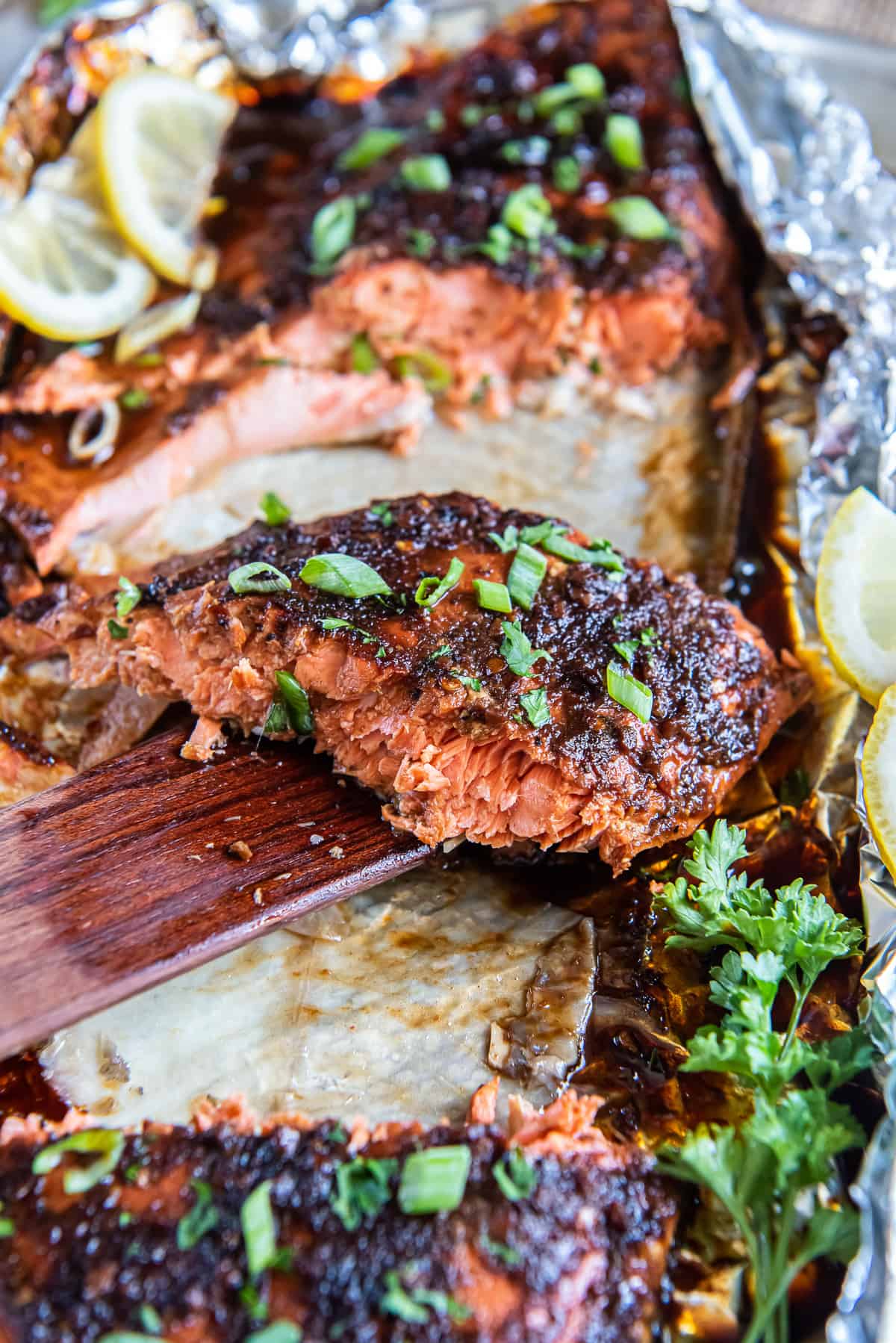
Does Sockeye Salmon Taste Better than Atlantic Salmon?
While this can be a matter of personal taste, wild sockeye salmon is more flavorful than farmed Atlantic salmon. It has a meaty, firm texture and bold salmon flavor that holds up well to powerful ingredients like the balsamic glaze in this recipe. Farmed Atlantic salmon is milder with bigger flakes and a more tender texture than sockeye salmon.
Is Sockeye Salmon Healthier than Atlantic Salmon?
Yes. Wild sockeye salmon typically has fewer contaminants, like antibiotics and pesticides, which are sometimes used in crowded fish farms. Their natural diet and lifestyle results in a far superior nutritional profile, with higher levels of omega-3 fatty acids and antioxidants and a lower fat content compared to farmed salmon.
Ingredient Notes
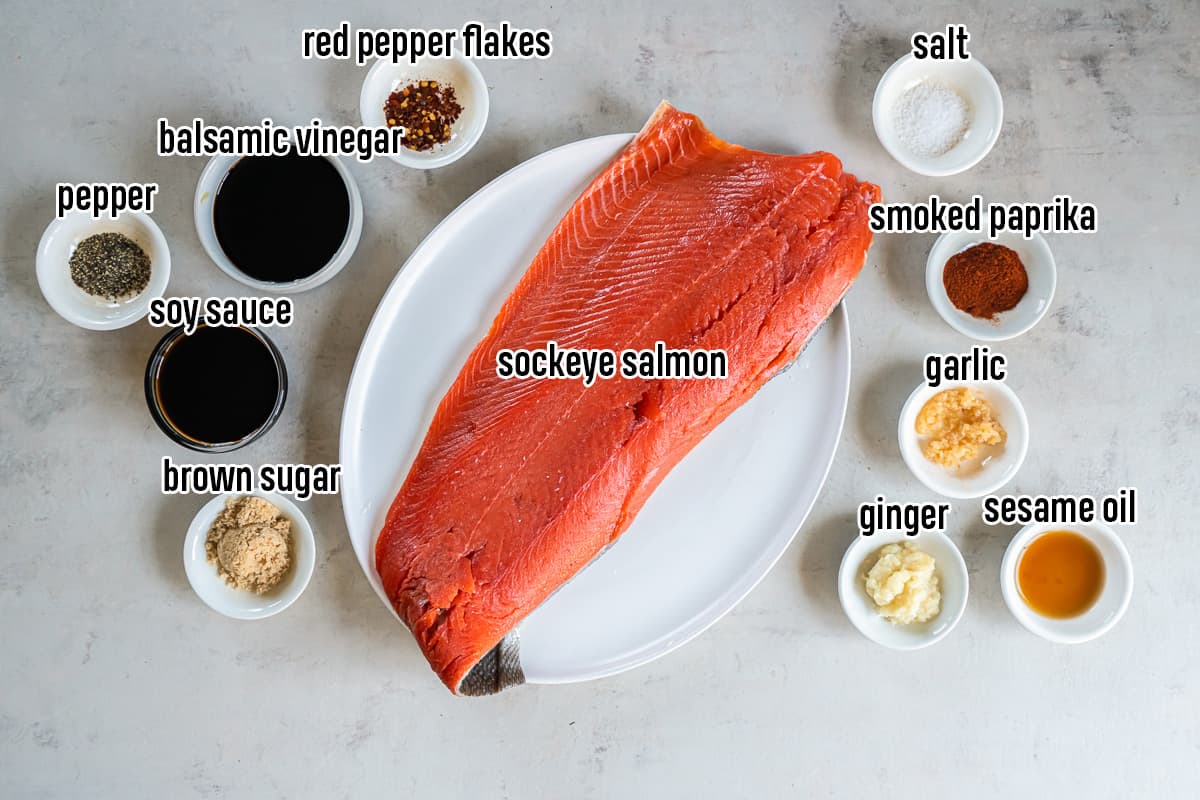
- Sockeye salmon – This recipe works well with a whole filet up to 1½ pounds. I get mine for a great price at Costco. You can also use this method with 4 to 6 individual sockeye salmon fillets.
- For the glaze – Balsamic vinegar, less sodium soy sauce, brown sugar, grated ginger root or ginger paste, minced garlic, sesame oil, smoked paprika, crushed red pepper flakes, salt and freshly ground black pepper.
- Garnish – Thinly sliced green onions or minced fresh parsley. Whenever I cook any type of seafood, I like to serve it with fresh lemon slices.
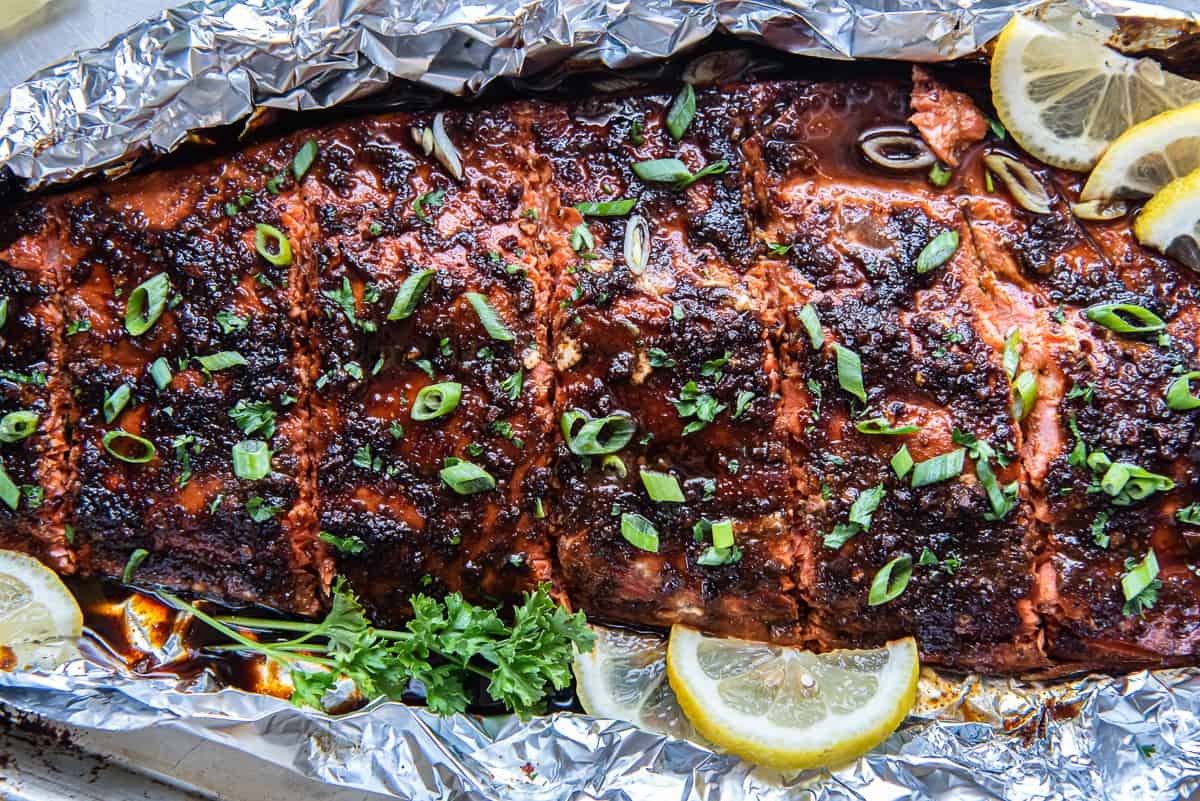
How to Make Sockeye Salmon
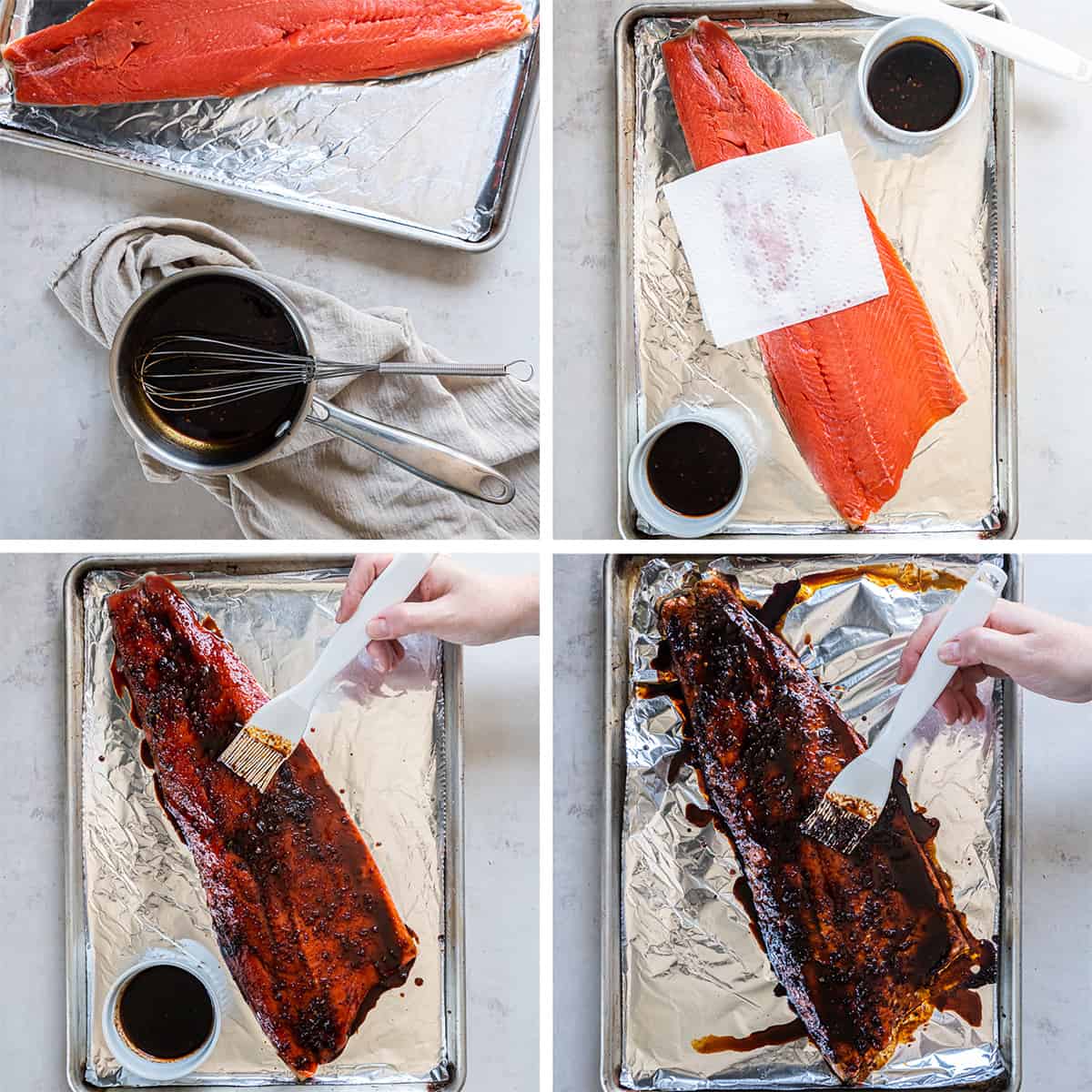
- Let the salmon rest at room temperature for 15 to 20 minutes before beginning. While the salmon rests, whisk together the glaze ingredients in a small saucepan and bring to a boil over medium heat. Then, reduce the heat to low and continue cooking until it’s bubbling around the edges and the glaze is reduced and slightly thickened.
- Divide the glaze evenly between two small bowls, one for basting the raw fish and one for basting the cooked fish. Place the salmon, skin side down, on foil or parchment paper-lined baking sheet and pat the surface dry with paper towels.
- Brush the salmon generously with one of the bowls of thickened glaze (if there is any glaze remaining in the bowl you used, toss it).
- Transfer the baking sheet to the oven and bake for 8 to 10 minutes, or until the salmon registers about 120 degrees F and appears to be nearly cooked through. Remove from the oven and baste the partially cooked salmon with the 2nd bowl of reserved glaze. Return it to the oven for an additional 2 to 4 minutes or until the salmon is cooked through and the sauce is lightly caramelized. Allow it to rest for a few minutes before serving.
Pro Tip
I recommend pulling salmon from the oven when it reaches 140 degrees F in the thickest portion. This is just shy of the USDA recommended temperature of 145 degrees F but the temperature will continue to rise slightly as it rests before serving.
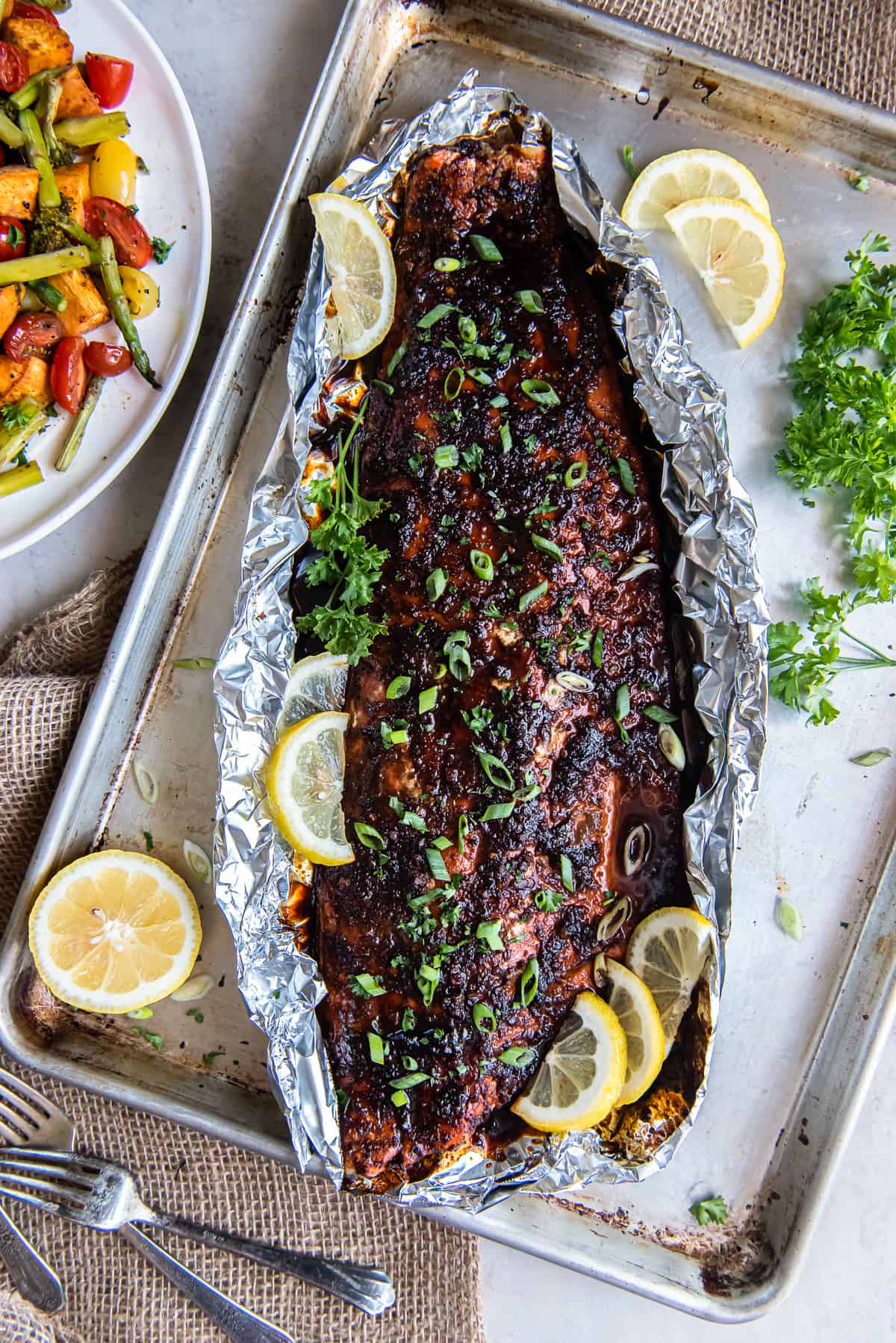
Serving Suggestions
Garnish: I think this Sockeye Salmon recipe benefits from a garnish of thinly sliced green onion or parsley for a pop of color against the dark background of the glaze.
Vegetables: When we’re watching our carb intake, I love to serve this salmon with my Sheet Pan Roasted Vegetables. More great choices include Pesto Green Beans or Brown Sugar Dill Carrots.
Potatoes: Carbs be darned, this glazed Sockeye Salmon is downright delicious served over a mound of Cheddar Mashed Potatoes. Or, go with Parsley Potatoes or simply Roasted Sweet Potatoes.
Rice: You can never go wrong with my super versatile Almond Rice Pilaf. The flavors of Cilantro Lime Rice or Coconut Rice would also work very well with this recipe.
Salad: Sockeye Salmon is delicious served with Lemon Parmesan Salad or Butter Lettuce Salad with Grapes and Gorgonzola.
Storage Tips
Promptly refrigerate leftover salmon in an airtight container for up to 3 to 4 days. Leftover salmon can be gently warmed in the microwave or serve it cold in a salad for a delicious lunch the next day!
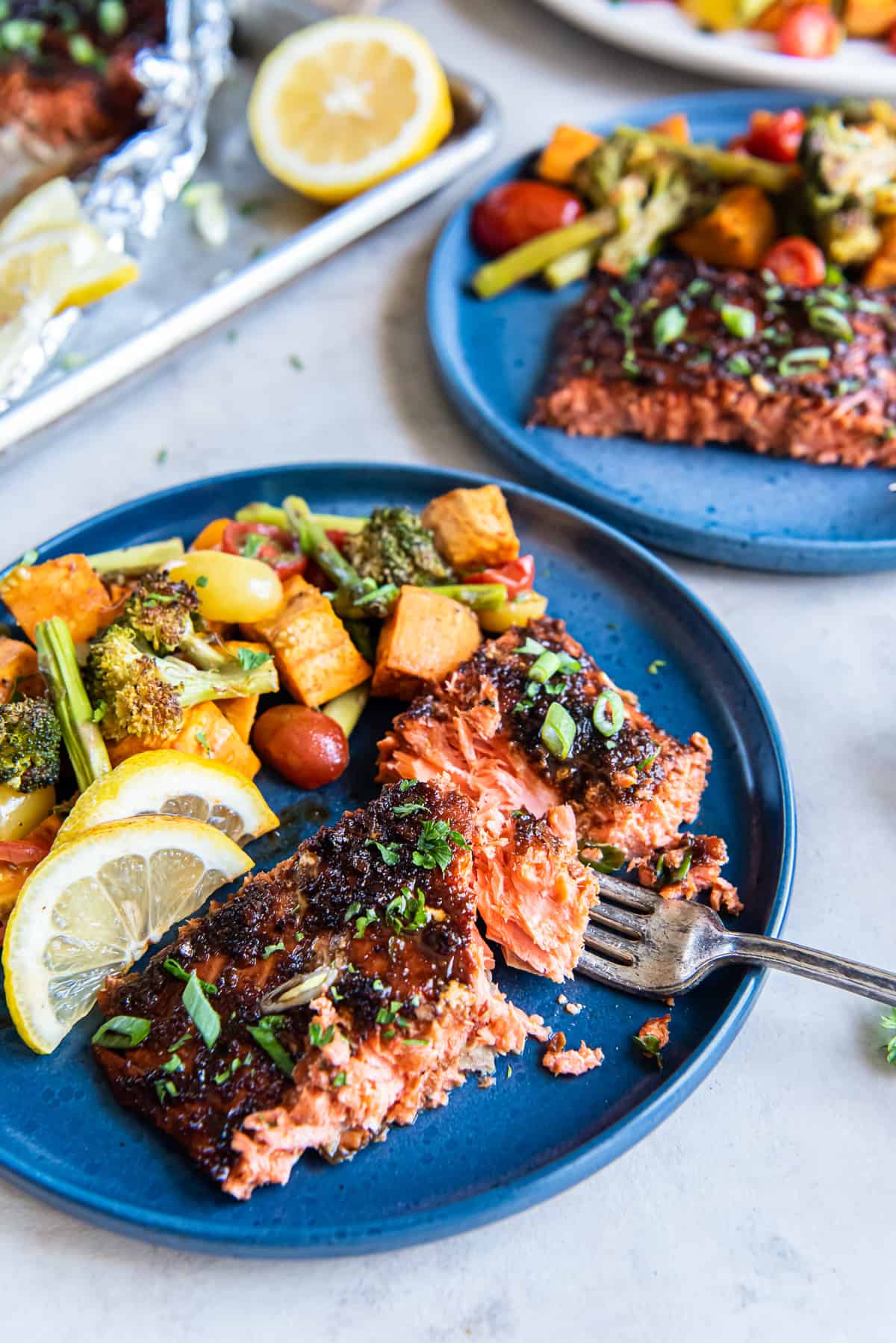
More Salmon Recipes You’ll Love
Sign up for my free newsletter for all the latest recipes and join me on Facebook, Instagram and Pinterest for more cooking inspiration!

Sockeye Salmon Recipe
This Sockeye Salmon recipe includes a rich, flavorful glaze and bakes quicky and easily in the oven. It’s an excellent choice for a healthy and absolutely delicious meal.
Ingredients
- 1 ½ pound sockeye salmon filet, or 4 to 6 individual filets
- ¼ cup balsamic vinegar
- ¼ cup less sodium soy sauce, or tamari for gluten free
- 1 tablespoon brown sugar
- 2 teaspoons grated ginger root or ginger paste
- 1 teaspoon minced garlic
- 1 teaspoon sesame oil
- 1 teaspoon smoked paprika
- ½ teaspoon crushed red pepper flakes, or to taste
- Salt and freshly ground black pepper, to taste
- ¼ cup thinly sliced green onions or minced fresh parsley (or both!), for garnish
Instructions
-
Let the salmon rest at room temperature for 15 to 20 minutes before beginning. (Allowing it to come to room temperature will help it cook more evenly but don’t leave it unrefrigerated for more than 30 minutes.)
-
In a small saucepan, whisk together the balsamic vinegar, soy sauce, brown sugar, ginger, garlic, sesame oil, smoked paprika, crushed red pepper flakes, salt, and pepper. Bring to a boil over MEDIUM heat. Reduce heat to LOW and continue cooking, bubbling around the edges, for about 6 to 8 minutes, stirring occasionally. Cook until the glaze is reduced by about ⅓ and slightly thickened (it will thicken quite a bit more after resting). Remove from the heat and divide it evenly between two small bowls, one for basting the raw fish and one for basting the cooked fish. Allow the glaze to rest while you preheat the oven.
-
Preheat oven to 400 degrees F and line a large rimmed baking sheet with heavy duty foil or parchment paper.
-
Place the salmon, skin side down, on the prepared baking sheet and pat the surface dry with paper towels. Brush the salmon generously with one of the bowls of thickened glaze (if there is any glaze remaining in the bowl you used, toss it).
-
Transfer the baking sheet to the oven and bake for 8 to 10 minutes or until the salmon registers about 120 degrees F and appears to be nearly cooked through (if salmon was very cold going into the oven this can take longer).
-
Remove from the oven and baste the salmon with the 2nd bowl of reserved glaze. Return it to the oven for an additional 2 to 4 minutes or until the salmon is cooked through and the sauce is lightly caramelized. USDA recommends an internal temperature of 145 degrees F but I think it’s best if it comes out of the oven at no more than 140 degrees F in the thickest portion. Then, let it rest a few minutes.
-
Garnish with the green onions or parsley and serve.
Notes
Promptly refrigerate leftover salmon in an airtight container for up to 3 to 4 days. Leftover salmon can be gently warmed in the microwave or serve it cold in a salad for a delicious lunch the next day!
Nutrition
Serving: 6 ounces · Calories: 284 kcal · Carbohydrates: 6 g · Protein: 36 g · Fat: 12 g · Saturated Fat: 2 g · Polyunsaturated Fat: 5 g · Monounsaturated Fat: 4 g · Cholesterol: 94 mg · Sodium: 802 mg · Potassium: 943 mg · Fiber: 1 g · Sugar: 4 g · Vitamin A: 451 IU · Vitamin C: 1 mg · Calcium: 38 mg · Iron: 2 mg
Nutrition information is automatically calculated using generic ingredients, and is an estimate not a guarantee. For more accurate results, please refer to the labels on your ingredients at home.




